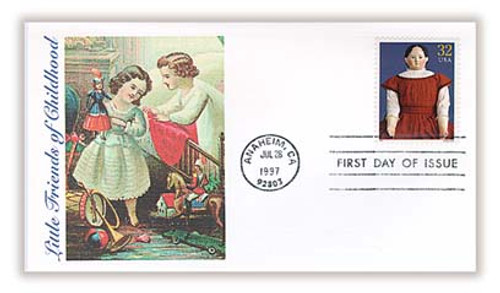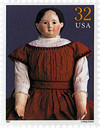
# 3151k - 1997 32c Classic American Dolls: Ludwig Greiner Doll
US #3151k
1997 Ludwig Greiner – Classic American Dolls
- Pictures a papier-mache and cloth doll made by Ludwig Greiner – the first doll to receive an American patent (March 30, 1858).
- Part of the Classic American Dolls set – the first time photographs were used instead of paintings or drawings for a large US set with different stamp designs
Stamp Category: Commemorative
Set: Classic American Dolls
Value: 32¢, First Class Mail Rate
First Day of Issue: July 28, 1997
First Day City: Anaheim, California
Quantity Issued: 105,000,000
Printed by: Printed for Ashton Potter (USA) Ltd. by Sterling Sommer of Tonawanda, New York
Printing Method: Offset
Format: Panes of 15 (Vertical, 5 across, 3 down)
Perforations: 10.9 by 11.1
Tagging: Large tagging block over all 20 stamps, covering the stamps to the edges
Why the stamp was issued: To commemorate the papier-mache and cloth dolls made by Ludwig Greiner. One of his dolls (the one pictured on the stamp) was the first-ever to receive an American patent (March 30, 1858).
About the stamp design: The stamp pictures a photograph of the doll against a blue paper background.
First Day City: The First Day of Issue Ceremony was held during the annual membership meeting of the United Federation of Doll Clubs at the Anaheim Hilton and Towers Hotel in Anaheim, California.
About the Classic American Dolls set: The USPS issued the stamps to commemorate American dolls that “reflect the tradition, heritage, culture, and artistic style from various geographical regions of this country.”
Each stamp design pictures a photograph by Sally Andersen-Bruce. Each doll or pair of dolls is shown in front of a blue paper background, tying the stamp designs together. The names of each doll are printed in small type below the bottom frameline of each stamp, across from the 1997 year date. They’re also listed in the horizontal selvage at the bottom of the pane of 15.
The set marked the first time photographs were used instead of paintings or drawings for a large US set with different stamp designs.
History the stamp represents: Listed as a “Toy Man” as early as 1840 in a Philadelphia directory, German-born Ludwig Greiner received the first-known American doll patent for manufacturing his paper-mâché – a substance referred to as “composition.” The original formula called for Spanish whiting (a gesso-like substance), white paper, rye flour, and glue. This was then pressed into a mold and the finished head was painted.
In his patent application, Greiner stated that the finished dolls’ heads were “painted with oiled paint so that children may not suck off the paint.” And although he advertised his product as “Greiner Everlasting Doll Heads,” the paint on the noses and chins frequently wore off from washing and handling. Even so, Greiner dolls are in great demand today.
Strongly influenced by the German china-head figures, Greiner’s dolls featured solemn faces and wavy molded hair. Early dolls have black hair; many made after 1872 are blond. Displayed on the front are several other period dolls from the Rosalie Whyel Museum of Doll Art, whose collection also includes an 1858 Greiner.
US #3151k
1997 Ludwig Greiner – Classic American Dolls
- Pictures a papier-mache and cloth doll made by Ludwig Greiner – the first doll to receive an American patent (March 30, 1858).
- Part of the Classic American Dolls set – the first time photographs were used instead of paintings or drawings for a large US set with different stamp designs
Stamp Category: Commemorative
Set: Classic American Dolls
Value: 32¢, First Class Mail Rate
First Day of Issue: July 28, 1997
First Day City: Anaheim, California
Quantity Issued: 105,000,000
Printed by: Printed for Ashton Potter (USA) Ltd. by Sterling Sommer of Tonawanda, New York
Printing Method: Offset
Format: Panes of 15 (Vertical, 5 across, 3 down)
Perforations: 10.9 by 11.1
Tagging: Large tagging block over all 20 stamps, covering the stamps to the edges
Why the stamp was issued: To commemorate the papier-mache and cloth dolls made by Ludwig Greiner. One of his dolls (the one pictured on the stamp) was the first-ever to receive an American patent (March 30, 1858).
About the stamp design: The stamp pictures a photograph of the doll against a blue paper background.
First Day City: The First Day of Issue Ceremony was held during the annual membership meeting of the United Federation of Doll Clubs at the Anaheim Hilton and Towers Hotel in Anaheim, California.
About the Classic American Dolls set: The USPS issued the stamps to commemorate American dolls that “reflect the tradition, heritage, culture, and artistic style from various geographical regions of this country.”
Each stamp design pictures a photograph by Sally Andersen-Bruce. Each doll or pair of dolls is shown in front of a blue paper background, tying the stamp designs together. The names of each doll are printed in small type below the bottom frameline of each stamp, across from the 1997 year date. They’re also listed in the horizontal selvage at the bottom of the pane of 15.
The set marked the first time photographs were used instead of paintings or drawings for a large US set with different stamp designs.
History the stamp represents: Listed as a “Toy Man” as early as 1840 in a Philadelphia directory, German-born Ludwig Greiner received the first-known American doll patent for manufacturing his paper-mâché – a substance referred to as “composition.” The original formula called for Spanish whiting (a gesso-like substance), white paper, rye flour, and glue. This was then pressed into a mold and the finished head was painted.
In his patent application, Greiner stated that the finished dolls’ heads were “painted with oiled paint so that children may not suck off the paint.” And although he advertised his product as “Greiner Everlasting Doll Heads,” the paint on the noses and chins frequently wore off from washing and handling. Even so, Greiner dolls are in great demand today.
Strongly influenced by the German china-head figures, Greiner’s dolls featured solemn faces and wavy molded hair. Early dolls have black hair; many made after 1872 are blond. Displayed on the front are several other period dolls from the Rosalie Whyel Museum of Doll Art, whose collection also includes an 1858 Greiner.










